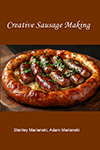Meats and Sausages
Buche de Costillas (Badajoz)
Buche de Costillas originates in Badajoz, the capital of the province of Badajoz in the region of Extremadura, Spain. The sausage is made from pieces of spare ribs, tails, snouts, tongues plus lean pork and fat. The mix is spiced, stuffed into pork stomachs and dried and aged. The buche sausage was produced and consumed in winter. The sausage was stored in stone jars filled with lard. Buche sausage was served by cooking it in large Dutch ovens over open fire. About 2 hours was needed to cook buche weighing 1 kg (2.2 lb). Chorizo sausage, pork shoulder, whole garlic cloves and red peppers were usually added and cooked in the same pot. Cabbage was always added to pot during last 30 minutes of cooking. Next the meats and vegetables were removed and rice was cooked in remaining meat stock. Then all was presented on a plate and served with red wine. Eating Buche in Extremadura was a social gathering, it was a party.
| Meats | Metric | US |
|---|---|---|
| Lean pork | 500 g | 1.10 lb |
| Back fat | 250 g | 0.55 lb |
| Tails | 50 g | 0.11 lb |
| Tongues | 50 g | 0.11 lb |
| Spare ribs | 50 g | 0.11 lb |
| Pig mask* | 100 g | 0.22 lb |
Ingredients per 1000g (1 kg) of meat
| Salt | 30 g | 5 tsp |
| Cure #2 | 3.0 g | 1/2 tsp |
| Dextrose | 5.0 g | 1 tsp |
| Pimentón | 25 g | 4 Tbsp |
| Garlic, smashed | 15 g | 4 cloves |
Instructions
- Cut all lean pork, fat, tails, tongues, spare ribs and face meats into smaller (finger length) pieces.
- Mix meats with salt and spices. Hold for 24 hours in refrigerator.
- Stuff into pork stomachs.
- Dry at 20° C (68° F) for 20 days.
- Dry at 15-10° C (59-50° F) for 1-2 months depending on the size of a stomach.
Notes
* pig mask is the face of the pig (cheeks, snout, ear) - skin with attached meat and small bones. It will not be easy to obtain in metropolitan areas so use dewlap (chin) or jowls (cheeks).
Consume sausage raw or cooked.
Consume sausage raw or cooked.

















